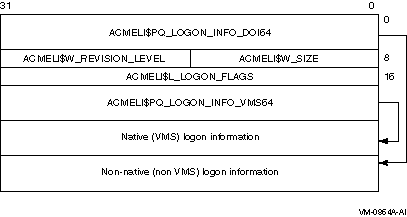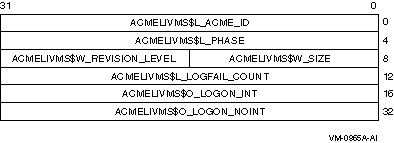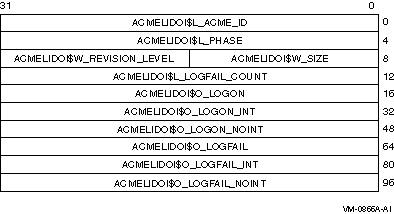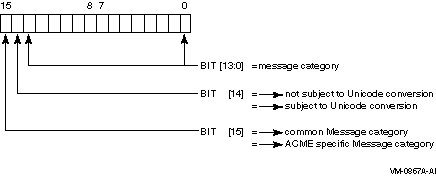| Previous | Contents | Index |
If this item code is specified, the ACME$_AUTH_MECHANISM and ACME$_RESPONSE_DATA item codes must also be specified. (The VMS domain of interpretation does not support this mechanism type.)
The $ACMEDEF macros defines the following symbols for the valid flags:
ACMEDLOGFLG$V_INPUT---character string input/output capabilities
ACMEDLOGFLG$V_NOECHO---"no echo" input capabilities
These are the same as those for the ACMEIS$L_FLAGS field on an item set entry. See the description of the context argument for further information.
Specify the ACME$_DIALOGUE_SUPPORT item code to indicate the interactive capabilities of the user interface. If the caller is unable to support features necessary to complete a given request, the request ultimately fails. The caller receives a condition value ACME$_INSFDIALSUPPORT for insufficient dialogue support.
The meaning of this data is specific to the domain of interpretation for which it is used.
The meaning of this data is specific to the domain of interpretation for which it is used.
The buffer must contain a string in the following case-insensitive syntax:
language-country
language is a 2-letter language code (ISO 639)
country is a 2-letter country code (ISO 3166)
The default is EN-US, and cannot be overridden by the specified locale. Locale information may be interpreted by ACME agents to determine country and language requirements.
The size of the buffer must be sufficient to handle data from whatever VMS versions are used, as described in the ACME$_LOGON_INFORMATION structure found in the HP OpenVMS Programming Concepts Manual.
The following diagram depicts the overall format of an ACM logon information structure:

The following table defines the ACM logon information structure header fields:
| Descriptor Field | Definition |
|---|---|
| ACMELI$PQ_LOGON_INFO_DOI64 |
In this situation, a quadword containing the 64-bit address of the
structure segment containing logon information relating to the
authenticating domain of interpretation.
When the ACM logon information structure resides in 32-bit address space, ACMELI$PQ_LOGON_INFO_DOI64 contains the sign-extended 32-bit address of the structure segment. The field can be referenced as a 32-bit signed pointer using ACMELI$PS_LOGON_INFO_DOI32. |
| ACMELI$W_SIZE | A word containing the size of the ACM logon information structure. |
| ACMELI$W_REVISION_LEVEL | A word containing a value that identifies the revision level of the ACM logon information structure. |
| ACMELI$L_LOGON_FLAGS | Specifies the structure ACMELGIFLG$TYPE, used by LOGINOUT to populate the longword returned by the item code JPI$_LOGIN_FLAGS when calling the SYS$GETJPI[W] system service. This provides the client with information regarding what took place during authentication. The ACM Dispatcher manages this item, sending back to the client the merge of all the output it receives from ACMEs by calls to the ACME$CB_SET_LOGIN_FLAG. For the information that is received, see the HP OpenVMS Programming Concepts Manual. |
| ACMELI$PQ_LOGON_INFO_VMS64 |
In this situation, a quadword containing the 64-bit address of the
structure segment containing logon information about the native (VMS)
domain of interpretation.
When the ACM logon information structure resides in 32-bit address space, ACMELI$PQ_LOGON_INFO_VMS64 contains the sign-extended 32-bit address of the structure segment. The field can be referenced as a 32-bit signed pointer using ACMELI$PS_LOGON_INFO_VMS32. |
The following diagram depicts the format of the ACM logon structure segment containing information about the VMS domain of interpretation:

The following table defines the fields for the ACM logon structure segment containing logon information about the native (VMS) domain of interpretation:
| Descriptor Field | Definition |
|---|---|
| ACMELIVMS$L_ACME_ID | A longword containing the agent ID of the ACME agent that reported logon information for the native (VMS) domain of interpretation. If this field is zero, the rest of the structure segment is invalid. |
| ACMELIVMS$L_PHASE | Indicates the ACME Execution Phase during which this value was provided. ACME Execution Phase numbers are subject to change, so this field is mainly for use by programmers to debug an ACME agent. |
| ACMELIVMS$W_SIZE | A word containing the size of the ACM logon information structure segment. |
| ACMELIVMS$W_REVISION_LEVEL | A word containing a value that identifies the revision level of the ACM logon information structure segment. |
| ACMELIVMS$L_LOGFAIL_COUNT | A longword containing the number of failed logon attempts with respect to the VMS domain of interpretation. |
| ACMELIVMS$O_LOGON_INT | An octaword containing the date and time in UTC format of the last interactive logon with respect to the VMS domain of interpretation. If the contents of the octaword are zero, no previous non-interactive logon with respect to the VMS domain of interpretation was recorded. |
| ACMELIVMS$O_LOGON_NONINT | An octaword containing the date and time in UTC format of the last noninteractive logon with respect to the VMS domain of interpretation. If the contents of the octaword are zero, no previous non-interactive logon with respect to the VMS domain of interpretation was recorded. |
The following diagram depicts the format of the ACM logon structure segment containing information about the authenticating domain of interpretation:

The following table defines the fields for the ACM logon structure segment containing logon information about the authenticating domain of interpretation:
| Descriptor Field | Definition |
|---|---|
| ACMELIDOI$L_ACME_ID |
A longword containing the agent ID of the ACME agent that reported
logon information about the non-native authenticating domain of
interpretation. If this field is zero, the rest of the structure
segment is invalid.
If the contents of the longword are zero, the principal was authenticated for the VMS domain of interpretation. |
| ACMELIDOI$L_PHASE | Indicates the ACME Execution Phase during which this value was provided. ACME Execution Phase numbers are subject to change, so this field is mainly for use by programmers to debug an ACME agent. |
| ACMELIDOI$W_SIZE | A word containing the size of the ACM logon information structure segment. |
| ACMELIDOI$W_REVISION_LEVEL | A word containing a value that identifies the revision level of the ACM logon information structure segment. |
| ACMELIDOI$L_LOGFAIL_COUNT | A longword containing the number of failed logon attempts with respect to the non-native authenticating domain of interpretation. |
| ACMELIDOI$O_LOGON |
An octaword containing the date and time in UTC format of the last
logon with respect to the non-native authenticating domain of
interpretation.
If the contents of the octaword are zero, no previous logon with respect to the domain of interpretation was recorded. |
| ACMELIDOI$O_LOGON_INT |
An octaword containing the date and time in UTC format of the last
interactive logon with respect to the non-native authenticating domain
of interpretation.
If the contents of the octaword are zero, no previous interactive logon with respect to the domain of interpretation was recorded. |
| ACMELIDOI$O_LOGON_NONINT | An octaword containing the date and time in UTC format of the last noninteractive logon with respect to the non-native authenticating domain of interpretation. If the contents of the octaword are zero, no previous non-interactive logon with respect to the domain of interpretation was recorded. |
| ACMELIDOI$O_LOGFAIL |
An octaword containing the date and time in UTC format of the last
logon failure with respect to the non-native authenticating domain of
interpretation.
If the contents of the octaword are zero, no previous logon failure with respect to the domain of interpretation was recorded. |
| ACMELIDOI$O_LOGFAIL_INT | An octaword containing the date and time in UTC format of the last interactive logon failure with respect to the non-native authenticating domain of interpretation. If the contents of the octaword are zero, no previous interactive logon failure with respect to the domain of interpretation was recorded. |
| ACMELIDOI$O_LOGFAIL_NONINT | An octaword containing the date and time in UTC format of the last noninteractive logon failure with respect to the non-native authenticating domain of interpretation. If the contents of the octaword are zero, no previous non-interactive logon failure with respect to the domain of interpretation was recorded. |
The $ACMEDEF macro defines the following symbols for the valid logon types:
ACME$K_DIALUP
ACME$K_LOCAL
ACME$K_REMOTE
ACME$K_BATCH
ACME$K_NETWORK
The values ACME$K_BATCH and zero (0) for batch and detached processes, respectively, are reserved to LOGINOUT.EXE. If either of these values is defaulted or specified by non-LOGINOUT clients, the service returns ACME$_INVREQUEST.
The maximum data returned for this item code is the number of characters represented by the symbol, ACMEVMS$S_MAX_VMS_USERNAME, so a caller's buffer should be at least that long, with the number of bytes allocated dependent on whether the ACME$M_UCS2_4 function code modifier was specified on the call to $ACM[W].
Data returned for this item code is the number of characters represented by the symbol, ACME$K_MAXCHAR_DOI_NAME, so a caller's buffer should be at least that long, with the number of bytes allocated dependent on whether the ACME$M_UCS2_4 function code modifier was specified on the call to $ACM[W].
This item code might be requested in a dialogue step.
This item code might be requested in a dialogue step.
The $ACMEDEF macros defines the following symbols for the valid flags:
ACMEPWDFLG$V_SYSTEM
ACMEPWDFLG$V_PASSWORD_1
ACMEPWDFLG$V_PASSWORD_2
This item code might be requested in a dialogue step.
This item code might be requested in a dialogue step.
This item code might be requested in a dialogue step.
This item code might be requested in a dialogue step.
If no ACME$_PERSONA_HANDLE_OUT item is specified but function modifier ACME$M_ACQUIRE_CREDENTIALS is specified, a persona that is created can be located with the $PERSONA_FIND system service.
Use of this item code is reserved to HP.
This item code might be requested in a dialogue step.
The maximum data returned for this item code is the number of characters represented by the symbol, ACME$K_MAXCHAR_PRINCIPAL_NAME, so a caller's buffer should be at least that long, with the number of bytes allocated dependent on whether the ACME$M_UCS2_4 function code modifier was specified on the call to $ACM[W].
The ACME$_QUERY_DATA item code requires that an ACME$_QUERY_TYPE item code immediately precede it in the item list.
An ACME$_QUERY_KEY_TYPE item requires an ACME$_QUERY_KEY_VALUE item immediately following it in the item list.
An ACME$_QUERY_KEY_VALUE item requires that an ACME$_QUERY_KEY_TYPE item immediately precede it in the item list.
The ACME$_QUERY_TYPE item code requires that an ACME$_QUERY_DATA item code immediately follow it in the item list.
The $ACMEDEF macro defines the following symbols for the standard address types:
| Symbol | Meaning |
|---|---|
| ACMEHAT$K_DECNET_IV | DECnet Phase IV |
| ACMEHAT$K_DECNET_OSI | DECnet OSI |
| ACMEHAT$K_IP_V4 | Internet Protocol V4 |
| ACMEHAT$K_IP_V6 | Internet Protocol V6 |
Interpretation of this data is specific to a domain of interpretation. This item code may be requested in a dialogue step.
Names beginning with x- are reserved for local use.
This item code also has an effect on the parsing of the list of ACME-specific item codes and takes effect immediately. It is in effect until the next instance of code ACME$_CONTEXT_ACME_ID, code ACME$_CONTEXT_ACME_NAME, code ACME$_TARGET_DOI_ID, or code ACME$_TARGET_DOI_NAME. It also specifies which ACME is to be responsible for the authentication.
The buffer must contain a longword value specifying the agent ID of a domain of interpretation.
This item code also has an effect on the parsing of the list of ACME-specific item codes, and takes effect immediately. It is in effect until the next instance of code ACME$_CONTEXT_ACME_ID, code ACME$_CONTEXT_ACME_NAME, code ACME$_TARGET_DOI_ID, or code ACME$_TARGET_DOI_NAME. It also specifies which ACME is to be responsible for the authentication.
The buffer must contain the case-insensitive name string of a domain of interpretation.
Timeout interval values are specified in seconds and must be between 1 and 300 seconds. If an invalid value is specified, the service returns SS$_IVTIME.
The default timeout interval is 30 seconds. This value may be adjusted by defining the exec mode logical name ACME$TIMEOUT_DEFAULT in the LNM$SYSTEM_TABLE logical name table. This timeout is enforced for non-dialogue requests and for the first request in a sequence of dialogue calls. The default value for subsequent dialogue requests can be adjusted by defining the exec mode logical name ACME$DIALOGUE_TIMEOUT_DEFAULT in the LNM$SYSTEM_TABLE logical name table.
Unprivileged clients can specify only timeout interval values less than or equal to the default value. Values greater than the default are ignored. Output Message Categories This section describes the various output message categories supported by the $ACM service.
Message Types are 16-bit unsigned values, encoded as follows:

Function-Independent Common Output Message Categories
The following table lists the function-independent common output messages and their meanings:
| Message Category | Meaning |
|---|---|
| ACMEMC$K_GENERAL | Specifies a general text message |
| ACMEMC$K_HEADER | Specifies a header text message |
| ACMEMC$K_TRAILER | Specifies a trailer text message |
| ACMEMC$K_SELECTION | Specifies an acceptable choices message |
| ACMEMC$K_DIALOGUE_ALERT | Specifies an advisory alert message |
Authentication Common Output Message Categories
The following table lists the authentication common output message categories and their meanings:
| Message Category | Meaning |
|---|---|
| ACMEMC$K_SYSTEM_IDENTIFICATION | Specifies system identification text messages |
| ACMEMC$K_SYSTEM_NOTICES | Specifies system notices |
| ACMEMC$K_WELCOME_NOTICES | Specifies welcome notices |
| ACMEMC$K_LOGON_NOTICES | Specifies logon notices |
| ACMEMC$K_PASSWORD_NOTICES | Specifies password notices |
| ACMEMC$K_MAIL_NOTICES | Specifies MAIL notices |
The Authentication and Credential Management ($ACM) service presents a unified interface for performing authentication-related operations in a manner independent of applicable policy.
Previous Next Contents Index